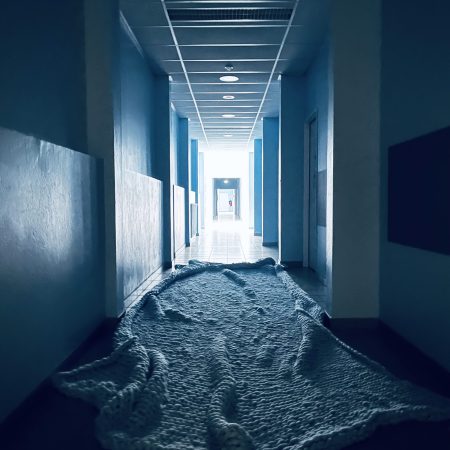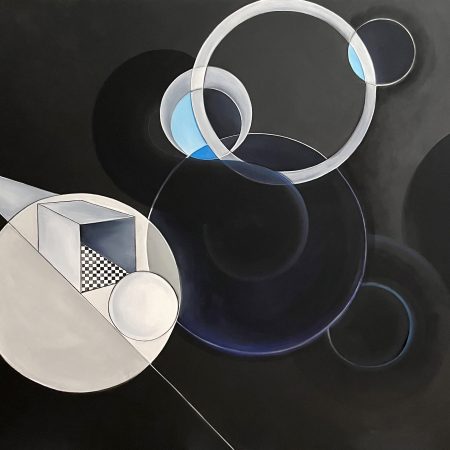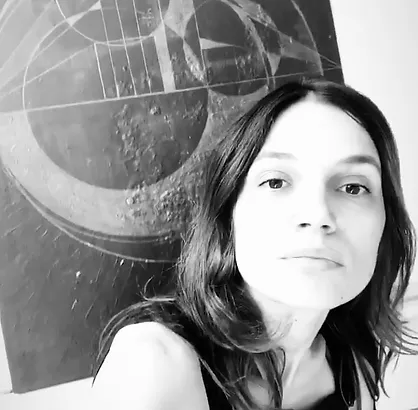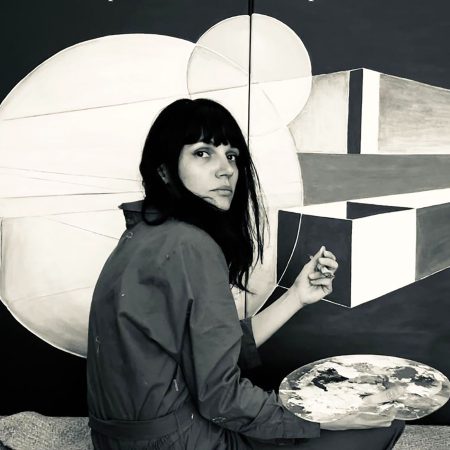Barbara Christol
Artistic Approach
Barbara Christol envisions creation as a labyrinth, where the artist moves forward at the crossroads through trial and error, chance, and repetition—while holding onto a guiding thread. For her, art is, above all, a game. And she plays it using variable-geometry practices. Initially oscillating between the three-dimensional staging of a recurring object and photography, her taste for play and spatial composition quickly evolved into a reflection on artistic creation conceived as a rhizome, where the artist operates through “displacements”—the central theme of her research.
Over the years, Barbara Christol’s work has taken on a distinctive form through the development of a nomadic visual practice, adaptable to the conditions of her solo travels around the world. She creates ephemeral weaving series using balls of yarn—a cherished material she has worked with for over 25 years—which she installs in nature, institutional spaces, and private settings. In her paintings and drawings, the thread is always present—either physically or through the omnipresent use of line—and through playful shifts in scale, she moves between figuration and abstraction.
Deeply committed to the artisanal dimension of her artistic practice, she primarily uses classical and traditional techniques and materials, which she reuses, blends, and reinterprets with more contemporary tools and methods. Somewhere between Ariadne and Penelope, Barbara Christol tirelessly weaves and unweaves her work.


I wish you were here
Critical Text
In one corner of the studio lies a mound of yarn balls, purchased back when the artist was studying in Paris, from a shop near the Sorbonne that was liquidating its stock. That was before the residency in Chile, before the collaboration with choreographer Kirsten Debrock, before returning to Nîmes—her birthplace, ultimately chosen as the territory of her studio. Soft wool, blue like childhood. An intimate azure, an emotional homeland—or rather a “matrie,” as Chateaubriand called his Breton roots. In paintings, the sky only became blue in the Middle Ages, as historian Michel Pastoureau reminds us, with the rise of Marian devotion. At the time, blue was seen as a warm color—elevating (a royal symbol) and consoling through its light.
In Barbara Christol’s practice, this blue—slightly faded, as if by time—redraws spaces through acts of weaving and unweaving; softening the edges of a table, a staircase; personalizing standardized environments—as during a long-term residency in a middle school, where students were invited to reclaim a space imposed upon them, and which many had come to resent. During lockdown, the artist explored online tutorials in search of new techniques: she embraced a thick, fleshy knit that doesn’t seek a motif at all costs. Loose enough to embrace without smothering. A blanket—always made from the same reserve of wool—that nestles into architecture, cradles the body, heals and comforts, in the spirit of Beuys, before returning to the studio to fill the void—or rather, the absence.
I Wish You Were Here
Blue now emerges in geometric paintings. An eruption of emotion into a world of matte blacks and sandy browns drawn with precision, creating a subtle dissonance. A shift in palette accompanied by a freer gesture, daring more organic loops, drawn freehand where compasses—of which the artist has a collection—once dictated the composition. Graph paper (often preserved since school days, in a kind of affective ecology) welcomes a new register of sensitivity, a fresh fragility brimming with vitality. Dunes, pyramids, arithmetic games, sketches of cities or cosmos come to life, rekindling the memory of the painted surface. A living memory, not an archive. A gesture that expands as the canvas grows—its size contingent on the studio space—a way for Barbara Christol to tame the frame, she who says she “loves drawing in painting (which still intimidates her a little), and vice versa.”
Now working with composer and musician Fabien Tolosa, and in partnership with France Alzheimer, she seeks a shared language to express illness—her mother’s—loss of identity, and the possibility of other forms of presence in the world. Conceived as nomadic, the upcoming installation MEM.MORI brings together found objects and sounds as fragments of autobiographical narratives without beginning or end—anonymous memories stitched together. Neuroscience now tells us that memory has no fixed seat in the brain, that encoding involves neural connections—this tentacular network—and chemical exchanges. MEM.MORI operates through and for circulation, a small factory of interaction, the starting point of a mediation project that will later travel to hospitals and care homes. A way to “respond to what happens,” borrowing the words of Vinciane Despret about the New Patrons program. A response that might overflow the question. A fabulation.
Céline Piettre (journalist and art critic, La Gazette Drouot)
À Propos
Représentation
Artsper
Singulart
Formations
* Université Panthéon-Sorbonne (Master 1 et 2 Mentions TB – Doctorat Arts 2005-2009), Paris
* Bourses de Recherches d’Etat 2002-2004
* Ateliers de peintres nîmois (Pascal Thouvenin, Jean-Pierre Hébrard)
* Cours des Beaux-Arts de Nîmes (Gérard Moschini)

BIOGRAPHY
Barbara Christol
Barbara Christol grew up immersed in artistic environments and developed an early passion for dance, piano, and the visual arts. As a young adult, she set aside scales and ballet shoes to devote herself fully to her consuming passion: drawing.
She pursued formal training at the École des Beaux-Arts in Nîmes, followed by intensive work in several local painters’ studios to refine her technique. Driven by a desire to explore her own aesthetic and visual research, she later enrolled at the Sorbonne in Paris, where she completed a doctoral thesis on the concept of the “transitional labyrinth.”
Often described as a “nomadic visual artist,” Barbara spent several years living between Paris and Santiago de Chile. She is now based in Nîmes, where she continues to participate in artist residencies and both national and international exhibitions—including the Salon des Beaux-Arts in Paris, the Sculpture Symposium in Chile, art fairs in Luxembourg and at London’s Saatchi Gallery, and galleries in Madrid and New York.
Her practice also includes collaborative projects with artists from other disciplines, particularly in dance and music.

À Propos
Représentation
Artsper
Singulart
Formations
* Université Panthéon-Sorbonne (Master 1 et 2 Mentions TB – Doctorat Arts 2005-2009), Paris
* Bourses de Recherches d’Etat 2002-2004
* Ateliers de peintres nîmois (Pascal Thouvenin, Jean-Pierre Hébrard)
* Cours des Beaux-Arts de Nîmes (Gérard Moschini)

